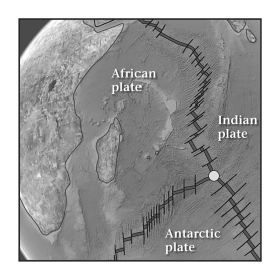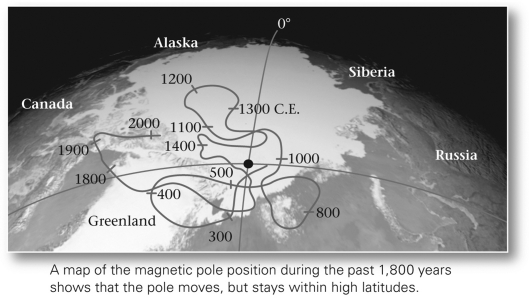A) India
B) southern Africa
C) North America
D) South America
Correct Answer

verified
Correct Answer
verified
Multiple Choice
Within the sea floor,the rate of geothermal heat flow is greatest ____________.
A) along mid-ocean ridges
B) along fracture zones
C) at the edges of ocean basins
D) in the center of abyssal plains
Correct Answer

verified
Correct Answer
verified
Multiple Choice
If a geologist discovered coal in a modern-day cold,snowy location,he or she could conclude that _____________.
A) a meteorite must have struck the area
B) the area was once covered with swamps and/or jungles
C) the area was once covered with an ocean
D) this discovery was anomalous
Correct Answer

verified
Correct Answer
verified
Multiple Choice
A volcanic island arc forms when _______________.
A) an oceanic plate subducts beneath continental lithosphere
B) an oceanic plate subducts beneath another oceanic plate
C) continental lithosphere subducts beneath an oceanic plate
D) two oceanic plates collide
Correct Answer

verified
Correct Answer
verified
Multiple Choice
Oceanic lithosphere thickens away from the mid-ocean ridge primarily due to ____________.
A) the addition of new crust due to hot-spot volcanism
B) the addition of new crust due to sedimentation
C) the addition of new lithospheric mantle as a result of cooling
D) reasons that geologists cannot determine at present
Correct Answer

verified
Correct Answer
verified
Multiple Choice
The age of oceanic crust ____________ with increasing distance from a mid-ocean ridge.
A) increases
B) decreases
Correct Answer

verified
Correct Answer
verified
True/False
A compass today points directly to geographic north.
Correct Answer

verified
Correct Answer
verified
Multiple Choice
A triple junction,like the one shown below,is a place on Earth's surface where ____________. 
A) three volcanoes form a tight, triangular cluster
B) glacial ice, continental rocks, and the ocean can be found together
C) the boundaries of three lithospheric plates meet at a single point
D) the boundaries of three lithospheric plates meet to form an elongate surface
Correct Answer

verified
Correct Answer
verified
Multiple Choice
According to the figure below,Earth's magnetic poles move constantly,but don't seem to stray farther than about ____________ from the geographic poles. 
A) 500 km
B) 1,000 km
C) 1,500 km
D) 2,000 km
Correct Answer

verified
Correct Answer
verified
Multiple Choice
The lithosphere of Earth can be bent and broken,but will not flow because it ____________.
A) is too old
B) is too dense
C) is too cool
D) contains radioactive elements
Correct Answer

verified
Correct Answer
verified
Multiple Choice
The primary difference between lithospheric and asthenospheric mantle that gives rise to numerous divergent patterns of physical behavior is ____________.
A) physical state (the lithosphere is solid; the asthenosphere is liquid)
B) chemical composition (the lithosphere is mafic; the asthenosphere is felsic)
C) temperature (the lithosphere is cooler than the asthenosphere)
D) chemical composition (the lithosphere is felsic; the asthenosphere is mafic)
Correct Answer

verified
Correct Answer
verified
Multiple Choice
Within the terminology of plate tectonics,an active margin is ____________.
A) synonymous with "subduction zone"
B) a 5-mile radius surrounding an active volcano
C) a continental coastline that coincides with a plate boundary
D) anywhere on Earth where earthquakes are especially frequent
Correct Answer

verified
Correct Answer
verified
Multiple Choice
The lithosphere of the Earth is generally thickest at and near ____________-plate boundaries.
A) convergent
B) divergent
C) transform
Correct Answer

verified
Correct Answer
verified
Multiple Choice
According to Wegener,puzzle pieces are to a jigsaw puzzle as ____________ is/are to Pangaea.
A) continental drift
B) continents
C) faults
D) plate tectonics
Correct Answer

verified
Correct Answer
verified
Multiple Choice
What mineral is integral to paleomagnetism?
A) magnetite
B) iron
C) quartz
D) potassium feldspar
Correct Answer

verified
Correct Answer
verified
Multiple Choice
Unlike the lithosphere,the asthenosphere ____________.
A) is able to flow over long periods of time
B) has a density similar to the core
C) varies in thickness from place to place
D) is relatively cool
Correct Answer

verified
Correct Answer
verified
Multiple Choice
The apparent polar wander path obtained from magnetite crystals in basalts on the North American continent is now interpreted to be the result of ____________.
A) wandering of the geomagnetic North Pole
B) drifting of the North American continent
Correct Answer

verified
Correct Answer
verified
Multiple Choice
Mid-ocean ridges are ____________.
A) convergent-plate boundaries
B) divergent-plate boundaries
C) transform-plate boundaries
Correct Answer

verified
Correct Answer
verified
Multiple Choice
A guyot is ____________.
A) any portion of the ocean floor that is topographically higher than surrounding sea floor
B) an extinct oceanic hot-spot volcano that has not yet subsided below sea level
C) an extinct oceanic hot-spot volcano that has subsided below sea level
D) synonymous with the term hot spot
Correct Answer

verified
Correct Answer
verified
Multiple Choice
The magnetic field of Earth in the geologic past is ____________.
A) unknown, but it is assumed to have been identical to today's
B) known to have been constant through geologic time, due to remnant magnetization of iron-rich minerals in rocks
C) known to have experienced numerous polarity reversals, due to remnant magnetization of iron-rich minerals in rocks
D) known to have been constant through time, on the basis of theoretical calculations
Correct Answer

verified
Correct Answer
verified
Showing 61 - 80 of 125
Related Exams